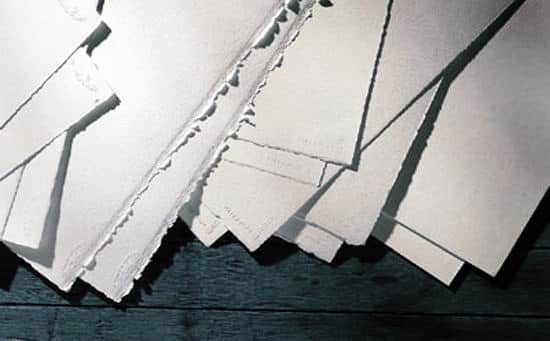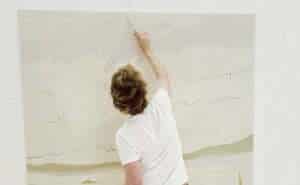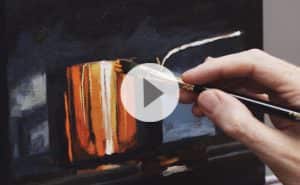
“First of all respect your paper!”
J.M.W.Turner
Ever walked into an art shop and felt daunted by the sheer volume of paper choices with confusing names, got flustered and walk out?!
You are not alone!
Choosing the correct watercolour paper doesn’t have to be as complicated as Manufacturers seem to make it…
As with most things in life, you get what you pay for.
The more expensive the paper, the better quality, and if you always opt for the cheapest choice because you don’t feel your paintings ‘deserve’ a better paper, you’ll be doing your art a disservice and fighting a losing battle.
Cheaper paper buckles when you add water to it, tears when you try to erase it and rolls into lumps at the critical moment! Invest in better paper and maybe add a few pounds to your sale price!
With acrylic paint, it’s easy to paint over mistakes, but watercolour is very unforgiving. Your paper can save you.
There are 3 ways of producing watercolour paper and 3 different textures available.
- Made by Hand – These papers are made from textile fibres such as cotton, linen & hemp, and the surface has been sized usually with gelatine. This is a joy to work on because it’s durable, won’t buckle and has a lovely irregular texture. Usually 100% cotton or linen or a mix of rags – hence the term ‘100% cotton rag’. It can be expensive but well worth it for a special piece. The quality, properties & prices of these papers depend on where they were made, so some experimentation is advised.
- Mould-made Paper – These are often made with a mix of paper fibres and/or cotton rather than 100% cotton. The fibres are formed into sheets on cylinder-mould machines; these give the paper a more uniform structure than the handmade paper. However, in practice, it can feel much more like handmade paper; it’s also durable, extremely stable and doesn’t buckle if you put loads of washes on.
- Machine-made Paper – This will be more reasonably priced and extremely regular; it can be made of more paper fibres and less cotton. Sometimes wood-pulp is used, which is a cheaper raw material, this produces a less durable paper (imagine trying to scrub in a colour as it’s going wrong and then… disaster strikes as the paper disintegrate under your brush!!!!) also, due to the Acidic lignin content in the wood-pulp, it can yellow over time.
Pro Tip: The best wood pulp papers are known as “woodfree” paper made with chemical wood-pulp. The paper’s acidic lignin content has been taken out, making a yellowing of the fibres less likely over time.
How is Handmade Watercolour paper made?
A selection of cellulose fibres (usually cotton, linen, hemp) is beaten in water to a pulp. An alkaline buffer may be added to give the paper a neutral ph value (brown paper, newsprint, or acidic content).
The pulp is transferred to a vat, and the sheets are made one at a time by a skilled craftsman using a flat paper mould.
The pulp is prevented from running off the mould’s sides by a narrow, removable frame called a deckle.
However, with use, the deckle becomes loose & a thin layer of pulp gets underneath it. This causes the sheet to have a characteristic frilly edge called a ‘deckle edge’.
Once formed, each sheet is laid onto a felt & the process of sheet formation is repeated until a pile of felts interleaved layers of pulp are formed. This pile is pressed to remove the water.
The imprint of the felt gives the paper its initial texture.
The sheets are removed from the press, parted from the felts and dried. After being inspected for flaws, they are then given a coat of gelatine size & dried again.
Before being dispatched, they may be given a final inspection & pressing.
Some papers are tougher than others & this is due to subtle variations in the way they are made. For instance, the fibre selection used, the pressure used to consolidate the sheet and the concentration and method used to harden the gelatine size will all affect how the paper reacts.
The best handmade watercolour paper will be a joy to work with and gives beginners a tough, forgiving surface.
P.S. A big thanks to Chris from Griffen Mill handmade paper for his help and advice on the process of making handmade watercolour paper.
The 3 surfaces of Watercolour paper
There are 3 surfaces of watercolour paper: Rough, hot-pressed (HP), and cold-pressed (NOT).
Rough – A pronounced, varied texture, great for a textured, loose feel.
Hot-pressed (HP) – Watercolor paper with a very smooth surface and almost no tooth. Good for painting detailed paintings and creating very smooth washes.
Cold-pressed (NOT) – It’s the paper texture in-between rough and hot-pressed paper; having a slightly textured surface, this paper is sometimes called NOT. The Not stands for “Not Hot pressed”
How much will it cost?
- Made by hand Paper 300gsm (140lb) Not 22″ x 30″- £8
- Mould-made Paper 300gsm (140lb) Not 22″ x 30″– £2.50
- Machine made Paper 300gsm (140lb) Not 22″ x 30″– £1.65
So for my money, I would work on a 300gsm (140lb) Cold-pressed mould-made paper to start with and then treat yourself to some handmade paper after a bit of practice!
Different Weights of Watercolour paper
Most decent watercolour paper is available in various weights, but the most commonly used are:
- 140 lb. 300 g/m2
- 300 lb. 638 g/m2
If you use heavy washes, the 140lb can buckle if the watercolour paper hasn’t been previously stretched. You can pre-stretch your watercolour paper; here is a demo – how to stretch watercolour paper.
If you don’t want to stretch the paper, then using a 300lb watercolour paper is the answer, but with the paper being double the thickness, it’s often double the price.
So it’s a choice between time and price to pre-stretch your own paper or pay for a more expensive paper but not have to stretch it.
You might also like:
1. Getting Started: A quick way to understand brushes + video – Overview of Acrylic brushes & video on brushes I use for a simple landscape
2. Getting Started: What Are Different Types of Paints made from? – Same pigment, different binder
3. The Essential Guide to Sketching the Landscape Course – Online Video Course so you can take the next step from sketching at home to sketching outdoors





Hello, Will!
I love your site and the way that you teach. Will you have any lessons on watercolor painting?
Thanks!
Julie
Thanks Julie, I don’t currently have any lessons on watercolour painting, I cover a few watercolour markers technique with the landscape sketching course, but it’s not a general introduction to standard watercolours.
Cheers,
Will
Dear Will,
That’s ok — you’ve already got so many wonderful classes going, it would probably be too much to begin a whole new medium. I’ve taken your color mixing class, and will take your acrylic portrait class soon. And I’ve pored over your free videos and lessons.You are a great teacher. Thanks so much!
Julie
Thanks very much Julie, pleased you’ve been enjoying the courses.
Will
Good Morning Will,
I haven’t set up a still life for quite a while….but..after reading your suggestions on this I may just go and try it! Don’t have to leave the studio on this soggy day…just find some objects laying about! Starting my day right!
Good one Delores!